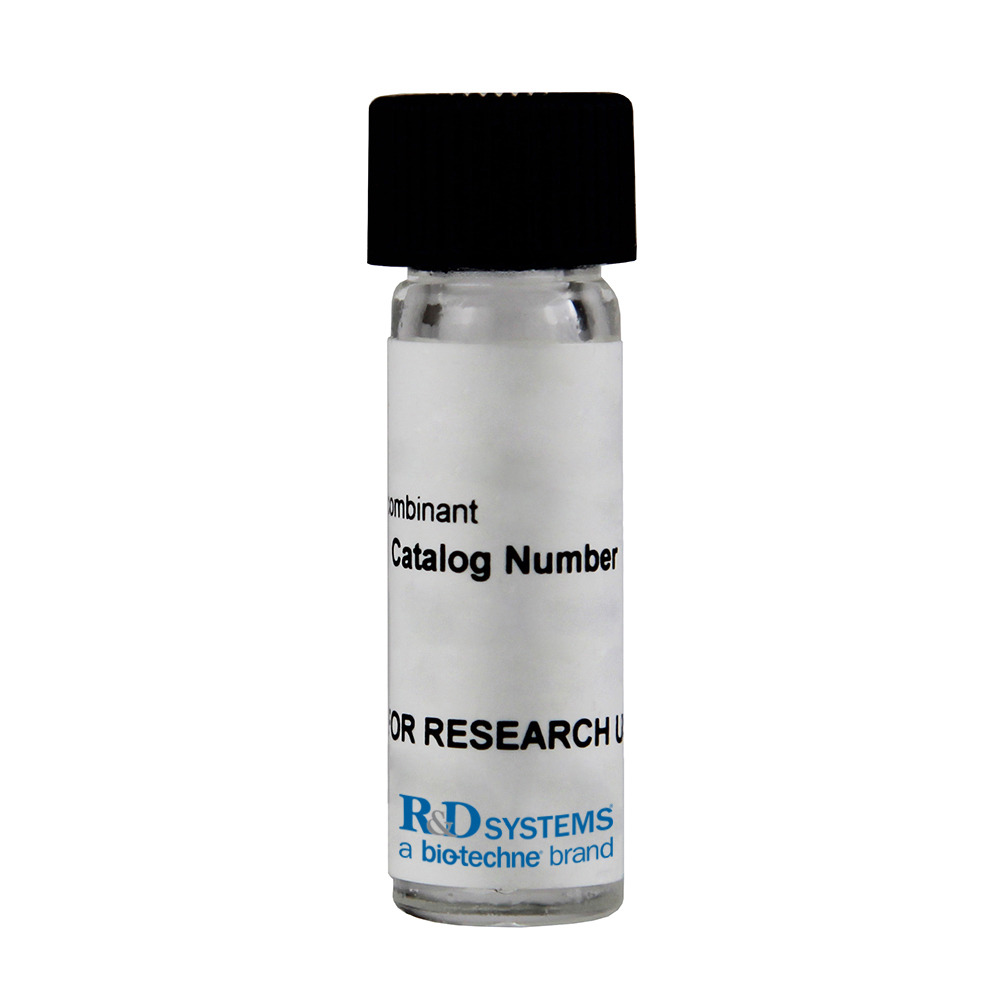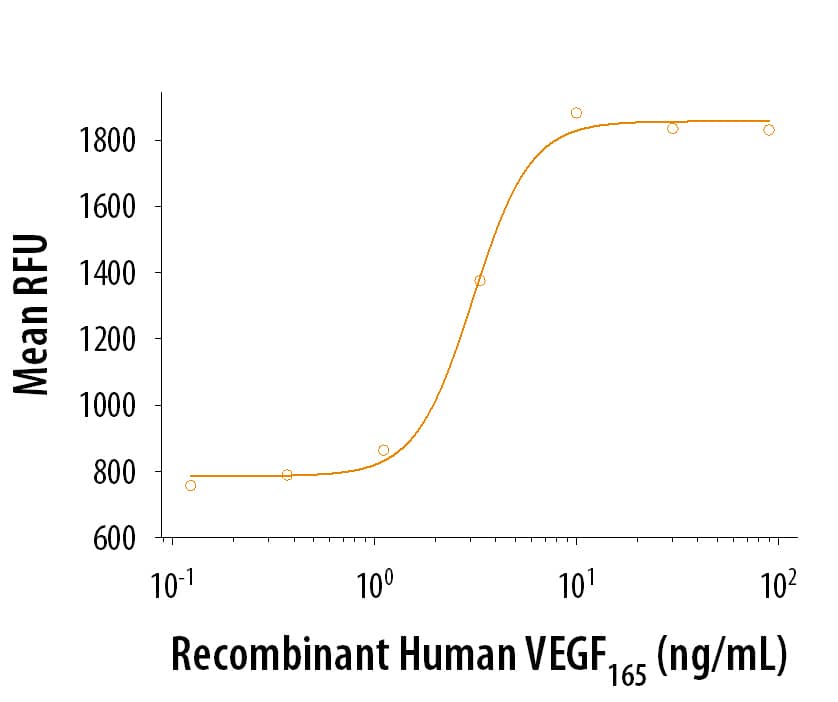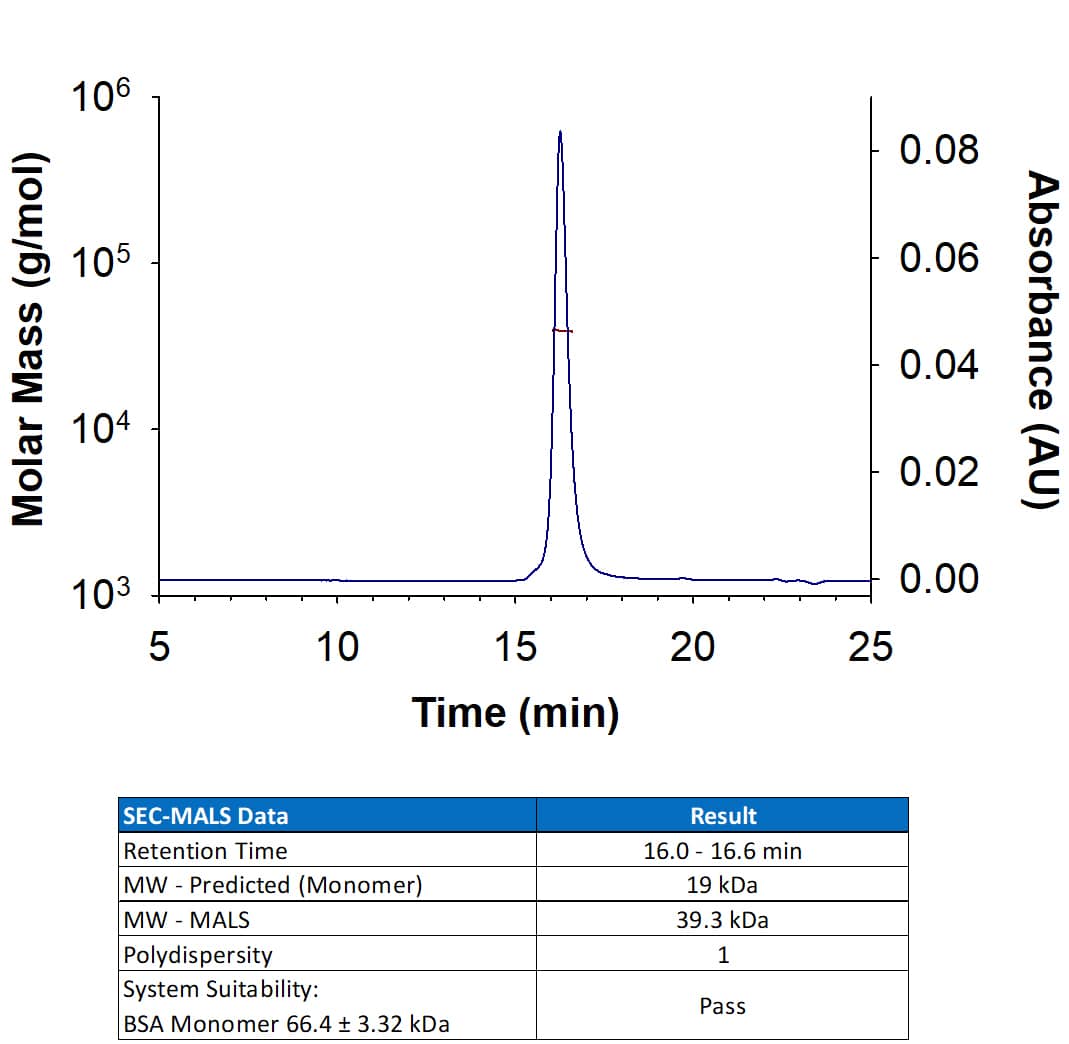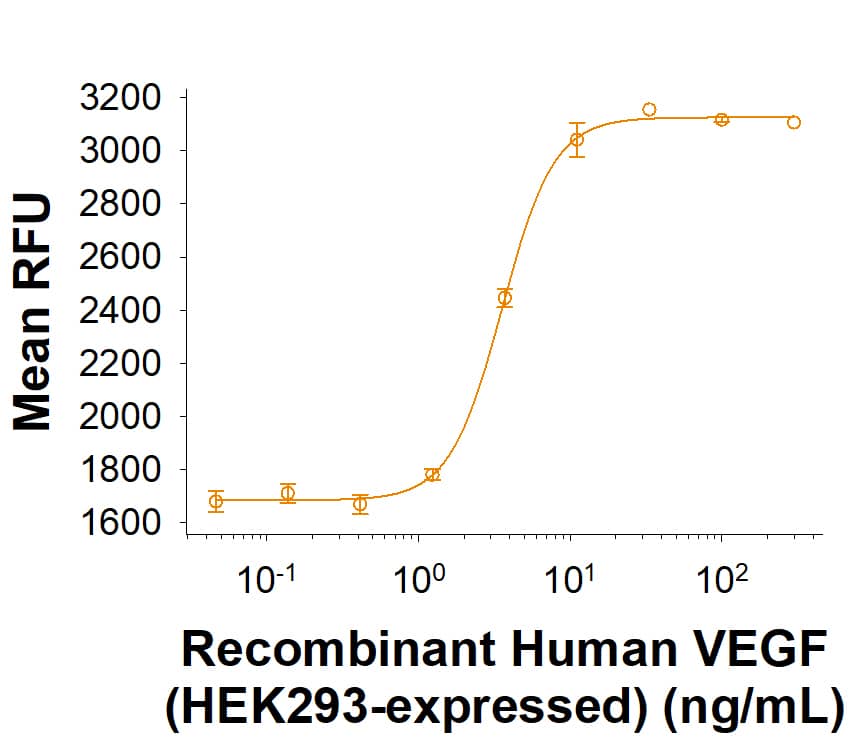Recombinant Mouse VEGF-B 186 Protein Summary
Product Specifications
Gln20-Ala207 & Gln20-Arg148
Analysis
Customers also Viewed
Product Datasheets
Carrier Free
CF stands for Carrier Free (CF). We typically add Bovine Serum Albumin (BSA) as a carrier protein to our recombinant proteins. Adding a carrier protein enhances protein stability, increases shelf-life, and allows the recombinant protein to be stored at a more dilute concentration. The carrier free version does not contain BSA.
In general, we advise purchasing the recombinant protein with BSA for use in cell or tissue culture, or as an ELISA standard. In contrast, the carrier free protein is recommended for applications, in which the presence of BSA could interfere.
767-VE
| Formulation | Lyophilized from a 0.2 μm filtered solution in PBS with BSA as a carrier protein. |
| Reconstitution | Reconstitute at 10 μg/mL in sterile PBS containing at least 0.1% human or bovine serum albumin. |
| Shipping | The product is shipped at ambient temperature. Upon receipt, store it immediately at the temperature recommended below. |
| Stability & Storage: | Use a manual defrost freezer and avoid repeated freeze-thaw cycles.
|
767-VE/CF
| Formulation | Lyophilized from a 0.2 μm filtered solution in PBS. |
| Reconstitution | Reconstitute at 100 μg/mL in sterile PBS. |
| Shipping | The product is shipped at ambient temperature. Upon receipt, store it immediately at the temperature recommended below. |
| Stability & Storage: | Use a manual defrost freezer and avoid repeated freeze-thaw cycles.
|
Background: VEGF-B
Vascular endothelial growth factor B (VEGF-B; also known as VFR) is a member of the VEGF-PDGF supergene family of growth factor molecules (1 - 4). Five mouse members have been identified, including VEGF-A, -B, -C, -D, and PlGF(-2) (1, 5). VEGF family members are disulfide-linked homo- and heterodimeric proteins that are important regulators of vasculogenesis and lymphangiogenesis. Two isoforms of mouse VEGF-B are produced by alternative splicing (6, 7). The long form (VEGF186) is 207 amino acids (aa) in length, with a putative 21 aa signal sequence and a 186 aa (32 kDa) mature region. The short form (VEGF167) is 188 aa in length, with a 21 aa signal sequence and a 167 aa (21 kDa) mature segment. The two isoforms share the same N-terminal 94 aa residue containing the cysteine knot VEGF homology domain (6 - 8). VEGF186 is O-glycosylated; VEGF167 is not. VEGF167 binds heparin; VEGF186 does not. Thus, VEGF186 is secreted and freely diffusible in tissues (7). However, the VEGF-B167 isoform is the predominant form in tissue (9). Mouse VEGF-B186 shares 93% and 87% aa identity with bovine and human VEGF-B186, respectively. Mouse VEGF-B167 also shares 90% and 88% aa identity with bovine and human VEGF-B167, respectively. Unlike VEGF167, VEGF-B186 can undergo proteolytic processing to generate a partially processed 48 kDa heterodimer (16 kDa and 32 kDa) and a fully processed 32 kDa homodimer (two 16 kDa). Processing appears to occur at Arg 127 of the mature protein (10). VEGF-B can heterodimerize with VEGF (7). Both VEGF-B isoforms can bind to VEGF receptor 1 (VEGF R1), but not VEGF R2 or VEGF R3 (11). VEGF-B167 also binds neuropilin-1, but only the 127 aa processed form of VEGF-B186 binds neuropilin-1 (10). As a dimer, the full length VEGF-B186 does not interact with neuropilin-1, while any dimer that contains the processed VEGF-B127 subunit will interact with neuropilin-1 (10). The importance of differential neuropilin binding is unclear. VEGF-B deficient mice display an atrial conduction deficit (12). On endothelial cells, ligation of VEGF R1 by VEGF-B has been shown to regulate the expression and activity of urokinase type plasminogen activator and plasminogen activator inhibitor 1 (11).
- Li, X. and U. Eriksson (2001) Int. J. Biochem Cell Biol. 33:421.
- Olofsson, B. et al. (1999) Curr. Opin. Biotechnol. 10:528.
- Clauss, M. (2000) Semin. Thromb. Hemost. 26:561.
- Matsumoto, T. and L. Claesson-Welsh (2001) Sci.STKE Dec 11 (112):RE21.
- DiPalma, T. et al. (1996) Mamm. Genome 7:6.
- Olofsson, B. et al. (1996) Proc. Natl. Acad. Sci. USA 93:2576.
- Olofsson, B. et al. (1996) J. Biol. Chem. 271:19310.
- Twonson, S. et al. (1996) Biochem. Biophys. Res. Commun. 220:922.
- Li, X. et al. (2001) Growth Factors 19:49.
- Makinen, T. et al. (1999) J. Biol. Chem. 274:21217.
- Olofsson, B. et al. (1998) Proc. Nat. Acad. Sci. USA 95:11709.
- Aase, K. et al. (2001) Circulation 104:358.
Citations for Recombinant Mouse VEGF-B 186 Protein
R&D Systems personnel manually curate a database that contains references using R&D Systems products. The data collected includes not only links to publications in PubMed, but also provides information about sample types, species, and experimental conditions.
5
Citations: Showing 1 - 5
Filter your results:
Filter by:
-
Targeting Vascular Endothelial Growth Factor Receptors as a Therapeutic Strategy for Osteoarthritis and Associated Pain
Authors: K Ma, G Singh, J Wang, I O-Sullivan, G Votta-Veli, B Bruce, AN Anbazhagan, AJ van Wijnen, HJ Im
International journal of biological sciences, 2023-01-01;19(2):675-690.
Species: Mouse
Sample Types: In Vivo
Applications: Bioassay -
Effects of imatinib on vascular insulin sensitivity and free fatty acid transport in early weight gain
Authors: CVJ Box, AK Sandhu, AH Turaihi, P Xiaoké, G Dallinga-T, J Aman, EC Eringa
PLoS ONE, 2021-07-02;16(7):e0250442.
Species: Human
Sample Types: Whole Cells
Applications: Bioassay -
A metabolite of branched chain amino acids drives vascular fatty acid transport and causes glucose intolerance.
Authors: Jang C.
Thesis.
Species: Mouse
Sample Types: Whole Cells
Applications: Bioassay -
Novel role for vascular endothelial growth factor (VEGF) receptor-1 and its ligand VEGF-B in motor neuron degeneration.
Authors: Poesen K, Lambrechts D, Van Damme P, Dhondt J, Bender F, Frank N, Bogaert E, Claes B, Heylen L, Verheyen A, Raes K, Tjwa M, Eriksson U, Shibuya M, Nuydens R, Van Den Bosch L, Meert T, D'Hooge R, Sendtner M, Robberecht W, Carmeliet P
J. Neurosci., 2008-10-15;28(42):10451-9.
Species: Mouse
Sample Types: In Vivo
Applications: In Vivo -
Modulation of angiogenesis by a tetrameric tripeptide that antagonizes vascular endothelial growth factor receptor 1.
Authors: Ponticelli S, Marasco D, Tarallo V, Albuquerque RJ, Mitola S, Takeda A, Stassen JM, Presta M, Ambati J, Ruvo M, De Falco S
J. Biol. Chem., 2008-10-15;283(49):34250-9.
Species: Mouse
Sample Types: N/A
Applications: ELISA (Standard)
FAQs
No product specific FAQs exist for this product, however you may
View all Proteins and Enzyme FAQsReviews for Recombinant Mouse VEGF-B 186 Protein
There are currently no reviews for this product. Be the first to review Recombinant Mouse VEGF-B 186 Protein and earn rewards!
Have you used Recombinant Mouse VEGF-B 186 Protein?
Submit a review and receive an Amazon gift card.
$25/€18/£15/$25CAN/¥75 Yuan/¥2500 Yen for a review with an image
$10/€7/£6/$10 CAD/¥70 Yuan/¥1110 Yen for a review without an image












